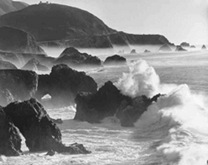 The Partnership for Sustainable Oceans has released a draft plan for Northern California Marine Life Protection Areas (MLPA) for consideration by the California Department of Fish and Game.
The Partnership for Sustainable Oceans has released a draft plan for Northern California Marine Life Protection Areas (MLPA) for consideration by the California Department of Fish and Game.
You may remember an early post on the Southern California Marine Preserves, this new plan is in response to the next round of legislated sanctuaries, covering Mendocino to San Mateo County.
The mouth of the Russian River is one of the candidates, and as the Russian still has a small steelhead run, you may want to keep an eye on the status of this plan so’s not to run afoul of new restrictions.
The proposal restricts both commercial and sport fishing for Point Arena, Sea Ranch, Salt Point, Russian River, Bodega Head, Point Reyes, Drake’s Bay, Fitzgerald (south of Pacifica), and the South East Farallon’s.
No timetable has been announced for acceptance of the proposal. The plan is available at the www.keepamericafishing.org website, and contains maps of the proposed sites as well as the custom restrictions for each preserve.
Technorati Tags: Partnership for Sustainable Oceans, MLPA, california marine preserve

KB,
Looking at it from a different perspective, commercial fishing can sometimes have less impact on a fish species than recreational fishing.
On the East coast, the striped bass have taken a tremendous hit from anglers; while at the same time, commercial fishermen have been severely restricted in their take. For example, in a 2004 report from MA:
“Summary: During 2005, the commercial fishery for striped bass in Massachusetts harvested about 59,473 fish weighing 1,104,737 pounds. Total losses due to commercial harvesting (including release mortality) were 64,807
fish weighing 1,149,570 pounds. The recreational fishery harvested about 380,788 striped bass weighing over 5.3 million pounds. Total losses due to recreational fishing (including release mortality) were 799,767 fish weighing over 7.3 million pounds. Combined losses (including scientific losses) were 844,899 fish weighing over 8.5 million pounds, which reflects a 9.6% decrease in numbers lost and a 6.4 % decrease in weight lost compared to 2004 (939,078 fish; 9.0 million pounds). The majority of losses, 92% by number and 86% by weight, was attributed to the recreational fishery.” (see http://www.mass.gov/dfwele/dmf/publications/tr28_stb_monitoring_2005.pdf )
KB,
to continue above. So, you will note from the stats that the recreational fishermen are killing far more fish by Catch & Release mortality (figured at 8% which is much lower than the 15% sometimes encountered with striped bass in warm waters, e.g., estuaries) than they harvest. This is just waste and greed – fishermen who are not content to catch just a few fish but must have 50 fish/day bragging rights.
It would seem from the above that Marine Sanctuaries must prohibit both commercial fishing and recreational fishing if they truly wish to protect a fishery. JMHO
That is an interesting document you cited, Reed. On first blush it would seem impossible that anglers could catch more than commercial fishermen, but the allowable season and day restrictions has the commercial lads handicapped.
No question that recreational fishing has a large impact, we like to think of ourselves as the “odd man out” but those numbers suggest otherwise.
The high human population of those areas are also a factor. That’s a lot of folks able to get off work and head for the beach.
I would assume that significant poaching (due to the proximity of a lot of humanity) also occured that would inflate the recreational numbers further.
I am going to use “Delta LogNormal” size algorithms for all my fish from now on. It will raise less eyebrows much less than your Einsteinian Phase-TimeShift computation.
…that and I won’t have to explain Gravitational Theory to the folks at the cocktail party.
KB,
The “Delta Log Normal” is simply a corruption of “Delta Dog” Norman, a particularly odious, and odorous, fisherman of the Louisiana bayous who was much given to lying about his catch rate. When the EPA heard of his phenomenal fishing success for catfish in the swamps, they sent a junior biologist down to interview him. Since the Harvard grad could not understand a word of Norman’s Cajun, as spoken through a full chew, he reduced the angler’s jibberish to mathematical jibberish he could understand – thus we have today the Delta Log Normal.
A dead fish is a dead fish, regardless what you call it, “sport” or “commercial”. I know of no other tool more effective than a partyboat full of gangion-jigging sports for vacuuming rockfish from a hard bottom spot. You can’t beat the “sport” presentation. And why do sports who injure and kill fish for fun and recreation think that they somehow have the moral high ground over commercials, who are simply a conduit of fish (as food) to the non-fishing public? First thing the MLPA people did when they took over the central coast was to divide commercial and sport fishermen in every way concievable, effectively derailing a united opposition, and effectively focusing the attention where they wanted it: on fishing as being the primary cause of diminished fish stocks, in spite of overwhelming evidence to the contrary. Curious to see if they use the same divide and conquer tactics on the north coast.